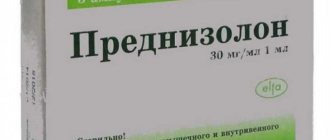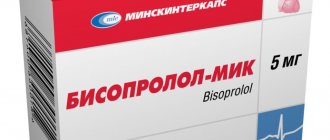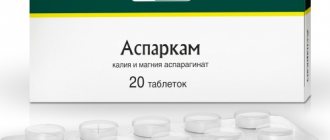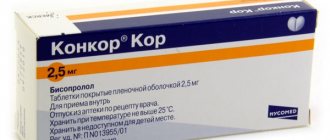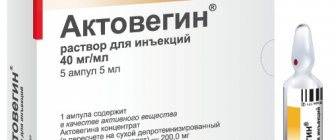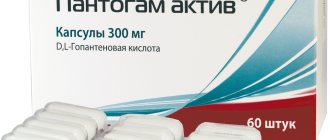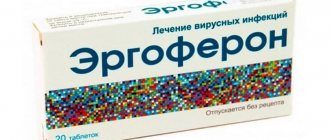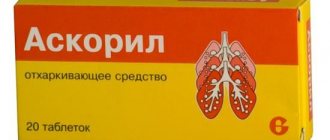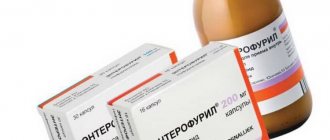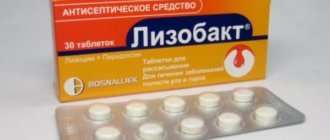Magnesia is a drug that has many pharmacological properties. It is used to lower blood pressure and fight parasites. The drug is prescribed even to pregnant women and children.
Instructions for using magnesia, what types of medicine exist, what states of aggregation it is in, how and in what cases it should be used, how to make injections. That's what this article is about.
What to do in such a situation? To get started, we recommend reading this article. This article describes in detail methods of controlling parasites. We also recommend that you consult a specialist. Read the article >>>
Dosage form - solution for intravenous administration [edit | edit code ]
Pharmacological action [edit | edit code ]
When administered parenterally, it has a sedative, diuretic, arteriodilatating, anticonvulsant, antiarrhythmic, hypotensive, antispasmodic effect; in large doses, it has a curare-like effect (inhibitory effect on neuromuscular transmission), tocolytic, hypnotic and narcotic effects, and suppresses the respiratory center. Mg 2+ is a “physiological” BMCC and is capable of displacing it from binding sites. Regulates metabolic processes, interneuronal transmission and muscle excitability, prevents the entry of Ca 2+ through the presynaptic membrane, reduces the amount of acetylcholine in the peripheral nervous system and central nervous system. Relaxes smooth muscles, reduces blood pressure (mostly elevated), increases diuresis. Anticonvulsant effect - Mg 2+ reduces the release of acetylcholine from neuromuscular synapses, while suppressing neuromuscular transmission, and has a direct inhibitory effect on the central nervous system. Antiarrhythmic effect - Mg 2+ reduces the excitability of cardiomyocytes, restores ionic balance, stabilizes cell membranes, disrupts the Na + current, the slow incoming Ca 2+ current and the one-way K + current. The cardioprotective effect is due to the expansion of the coronary arteries, a decrease in peripheral vascular resistance and platelet aggregation. Tocolytic effect - Mg 2+ inhibits the contractility of the myometrium (decreased absorption, binding and distribution of Ca 2+ in smooth muscle cells), increases blood flow in the uterus as a result of dilation of its vessels. It is an antidote for poisoning with heavy metal salts. Systemic effects develop almost immediately after intravenous and 1 hour after intramuscular administration. The duration of action with intravenous administration is 30 minutes, with intramuscular administration - 3-4 hours.
Side effects: From the digestive system: diarrhea, intestinal atony.
From the genitourinary system: symptom of kidney irritation, oliguria
From the cardiovascular system: tachycardia (rare)
Pharmacokinetics [edit | edit code ]
Anticonvulsant Css - 2-3.5 mmol/l. Penetrates the blood-brain barrier and the placental barrier, creating a concentration in breast milk that is 2 times higher than that in plasma. Excretion is carried out by the kidneys, its rate is proportional to plasma concentration and the level of glomerular filtration.
Indications [edit | edit code ]
- Threat of premature birth [1][2]
- Convulsions during gestosis
- Hypomagnesemia, including increased need for Mg 2+ and acute hypomagnesemia - tetany[3]
- Polymorphic ventricular tachycardia (pirouette type) [4]
- Arterial hypertension (including hypertensive crisis with symptoms of cerebral edema)
- Concussions
- Eclampsia[5]
- Encephalopathy, epileptic syndrome, urinary retention, poisoning with salts of heavy metals (mercury, arsenic, tetraethyl lead) [6].
- First aid for barium chloride poisoning [7]
- It is also used for severe attacks of bronchial asthma intravenously [8] and inhalation in combination with β2-agonists. [9]
Contraindications [edit | edit code ]
Hypersensitivity, arterial hypotension, depression of the respiratory center, severe bradycardia, AV block, severe chronic renal failure (creatinine clearance less than 20 ml/min), prenatal period (2 hours before birth). With caution: myasthenia gravis, respiratory diseases, chronic renal failure, acute inflammatory diseases of the gastrointestinal tract, pregnancy. It is strictly forbidden to use by people with kidney disease.
Dosage [edit | edit code ]
Intravenously and intramuscularly slowly (the first 3 ml - within 3 minutes), 5-20 ml of a 20-25% solution daily, 1-2 times a day for 15-20 days. For poisoning with mercury, arsenic, tetraethyl lead - IV, 5-10 ml of 5-10% solution. To relieve seizures in children - IM, 20-40 mg/kg (0.1-0.2 ml/kg 20% solution). The maximum dose is 40 g/day (160 mmol/day). In case of hypertensive crisis with suspected MI, only 5-10 ml of 20-25% magnesium sulfate solution is administered intramuscularly.
Side effects [edit | edit code ]
Early signs and symptoms of hypermagnesemia: bradycardia, diplopia, sudden “rush” of blood to the facial skin, headache, decreased blood pressure, nausea, shortness of breath, slurred speech, vomiting, asthenia. Signs of hypermagnesemia, ranked in order of increasing Mg 2+ concentration in the blood serum: decreased deep tendon reflexes (2-3.5 mmol/l), prolongation of the PQ interval and widening of the QRS complex on the ECG (2.5-5 mmol/l), loss of deep tendon reflexes (4-5 mmol/l), depression of the respiratory center (5-6.5 mmol/l), cardiac conduction disturbance (7.5 mmol/l), cardiac arrest (12.5 mmol/l). Symptom of kidney irritation. In addition, hyperhidrosis, anxiety, deep sedation, polyuria, uterine atony.
Overdose [edit | edit code ]
Symptoms: disappearance of the knee reflex, nausea, vomiting, sharp decrease in blood pressure, bradycardia, respiratory and central nervous system depression. Treatment: slow IV, CaCl2 or calcium gluconate solution - 5-10 ml 10%, oxygen therapy, carbogen inhalation, artificial respiration, peritoneal dialysis or hemodialysis, symptomatic therapy.
Special instructions [ edit | edit code ]
If simultaneous intravenous administration of Mg 2+ and Ca 2+ salts is necessary, they are injected into different veins. It is possible to use magnesium sulfate to relieve status epilepticus (as part of complex therapy). Patients with severe renal impairment should not receive more than 20 g of magnesium sulfate (81 mmol Mg 2+ ) within 48 hours; patients with oliguria or severe renal impairment should not administer magnesium sulfate intravenously too quickly. It is recommended to monitor the concentration of Mg 2+ in the blood serum (should not be higher than 0.8-1.2 mmol/l), diuresis (at least 100 ml/4 hours), respiratory rate (at least 16/min), and blood pressure. When used parenterally, special care should be taken to avoid creating toxic concentrations of the drug. Elderly patients often require a dose reduction (weakening of kidney function). The injection solution can also be used orally (as a laxative).
Interaction [edit | edit code ]
Enhances the effect of other drugs that depress the central nervous system. Cardiac glycosides increase the risk of conduction disturbances and AV block (especially with simultaneous intravenous administration of Ca 2+ salts). Muscle relaxants and nifedipine enhance neuromuscular blockade. When combined with parenteral magnesium sulfate and other vasodilators, the hypotensive effect may be enhanced. Barbiturates, narcotic analgesics, and antihypertensive drugs increase the likelihood of depression of the respiratory center. It interferes with the absorption of tetracycline antibiotics and weakens the effect of streptomycin and tobramycin. Ca 2+ salts reduce the effect of magnesium sulfate. Pharmaceutically incompatible (forms a precipitate) with Ca 2+ preparations, ethanol (in high concentrations), carbonates, bicarbonates and phosphates of alkali metals, salts of arsenic acid, barium, strontium, clindamycin phosphate, hydrocortisone sodium succinate, polymyxin B sulfate, procaine hydrochloride, salicylates and tartrates. At Mg 2+ concentrations above 10 mmol/ml in total parenteral nutrition formulas, separation of fat emulsions is possible.
Dosage form - powder [edit | edit code ]
The dosage forms in powder form are as follows:
- Powder for preparing a solution for oral administration.
- Powder for the preparation of suspension for oral administration.
Pharmacological action [edit | edit code ]
When taken orally, it has a choleretic (reflex effect on the receptors of the mucous membrane of the duodenum) and a laxative effect (due to poor absorption of the drug in the intestine, high osmotic pressure is created in it, water accumulates in the intestine, the intestinal contents are liquefied, peristalsis is enhanced). It is an antidote for poisoning with heavy metal salts. The onset of the effect is after 0.5-3 hours, duration is 4-6 hours.
Pharmacokinetics [edit | edit code ]
When taken orally, it is poorly absorbed (no more than 20%) in the jejunum and ileum, and is reabsorbed from bile, pancreatic and intestinal juice; with malabsorption syndrome and consumption of foods rich in fat, Mg 2+ absorption decreases. Communication with intracellular proteins and high-energy phosphates - 30%. TCmax - 4 hours. Mg 2+ is deposited in bones, skeletal muscles, kidneys, liver and myocardium; in small quantities - in tissue fluid and red blood cells. Penetrates the BBB and the placental barrier, creating a concentration in breast milk that is 2 times higher than that in plasma. Excretion is carried out by the kidneys (the rate of excretion by the kidneys is proportional to the concentration in plasma and the amount of glomerular filtration) and with feces.
Indications [edit | edit code ]
Constipation, cholangitis, cholecystitis, hypotonic dyskinesia of the gallbladder (for tubing), duodenal intubation (to obtain a cystic portion of bile), bowel cleansing before diagnostic procedures. Poisoning with salts of heavy metals (mercury, arsenic, tetraethyl lead, barium).
Contraindications [edit | edit code ]
Hypersensitivity, appendicitis, rectal bleeding (including undiagnosed), intestinal obstruction, dehydration, severe chronic renal failure, hypermagnesemia. With caution: heart block, myocardial damage, chronic renal failure.
Dosage [edit | edit code ]
As a laxative - orally, dissolving the contents of the package (20-30 g) in 100 ml of warm water, for children - at the rate of 1 g per 1 year of life. As a choleretic agent - orally, 15 ml of a 20-25% solution 3 times a day; during duodenal intubation, 50 ml of 25% or 100 ml of a 10% warm solution is administered through a probe. In case of poisoning with heavy metal salts, wash the stomach with a 1% solution of magnesium sulfate or give it orally (20-25 g in 200 ml of water to form insoluble barium sulfate). The maximum dose for adults is up to 40 g/day.
Side effects [edit | edit code ]
Nausea, vomiting, diarrhea, exacerbation of inflammatory diseases of the gastrointestinal tract, electrolyte imbalance (fatigue, asthenia, confusion, arrhythmia, convulsions), flatulence, spastic abdominal pain, thirst, signs of hypermagnesemia in the presence of renal failure (dizziness). Overdose: symptoms: severe diarrhea. Treatment is symptomatic.
Special instructions [ edit | edit code ]
The drug as a laxative is prescribed for occasional use only.
Interaction [edit | edit code ]
Reduces the effect of oral anticoagulants (including coumarin derivatives or indanedione derivatives), cardiac glycosides, phenothiazines (especially chlorpromazine). Reduces the absorption of ciprofloxacin, etidronic acid, tetracycline antibiotics (forms unabsorbed complexes with oral tetracyclines), weakens the effect of streptomycin and tobramycin (Mg 2+ laxatives - containing drugs should be taken 1-2 hours after using the above drugs). Pharmaceutically incompatible (precipitate is formed) with Ca 2+ preparations, ethanol (in high concentrations), carbonates, bicarbonates and phosphates of alkali metals, salts of arsenic acid, barium, strontium, clindamycin phosphate, hydrocortisone sodium succinate, polymyxin B sulfate, procaine hydrochloride, salicylates and tartrates.
Magnesium sulfate is a pharmaceutical preparation available for oral administration in the form of white powder or tablets. It has a bitter taste, a strong laxative effect and practically no side effects, however, there are certain contraindications to its use. Magnesia is widely used at home to cleanse the intestines, liver and gallbladder.
- Optimal body cleansing program using Epsom salts
- Using magnesia with mineral water
- Using magnesium to prepare for fasting
- Magnesium enema
- Contraindications
Anti-cellulite wraps with magnesium sulfate
You can use magnesium sulfate for weight loss for cellulite wraps.
In a course of 10 procedures, performed 2-3 times a week, you can lose 2-3 kg and significantly smooth out the hips and abdomen.
Wraps cleanse pores and accelerate cellular metabolism.
To carry them out, add 1-2 g of magnesia to any anti-cellulite product (cream, gel), or combine with honey, mustard powder and clay until a creamy consistency is obtained. The mass is applied to problem areas and wrapped in cling film. You need to lie under a blanket for 40-60 minutes, then wash off the mask with warm water.
Mechanism of action of the drug
The cleansing effect of magnesium sulfate is due to its powerful laxative effect. It is achieved by creating high internal osmotic pressure and accumulation of fluid in the intestines. This leads to increased contractile activity of its parts, irritation of receptors in the rectal wall, dilution of feces and their removal under pressure. The internal surfaces of the mucous membranes undergo high-quality cleaning.
Despite the relative safety of the drug (it is practically not absorbed into the bloodstream through the intestinal mucosa), its use at home should be agreed with a specialist. Uncontrolled use of medications can be dangerous and have serious negative consequences for health. Thus, if the dose or frequency of use is exceeded, magnesium sulfate can harm the friendly microflora of the internal environment of the body.
Indications for taking Epsom salts include:
Warning: It should be remembered that magnesium sulfate is not a sorbent.
Instructions for children
For minor patients, salt is used exclusively for medical reasons and after consultation with a doctor. Long courses of using the product for the purpose of cleansing from toxins, as well as forced stimulation of stool, are unacceptable.
Instructions for use prescribe dosing magnesium 1 gram per year of a child’s life. The volume of liquid is selected in proportion to the weight of the medicine. The ratio should be 1:5. The solution is drunk once, on an empty stomach. If the desired effect is not obtained, the drug is abandoned.
Advantages and disadvantages of the method
The main advantage of the method of cleansing the body with magnesium is its simplicity and effectiveness. The drug practically does not irritate the mucous membranes of the digestive tract and acts quickly. It does not affect the functioning of internal organs, is non-toxic and non-addictive, and provides a choleretic effect.
The danger is the development of the following side effects:
- death of the microflora of the digestive system;
- lazy bowel syndrome;
- dehydration, failure in the processes of water-salt metabolism (loss of calcium and sodium), edema;
- vomit;
- depression of cardiac activity;
- burning sensation in the anus, bleeding.
The amount of Epsom salt that does enter the bloodstream when passing through the gastrointestinal tract can cause a wave of side effects associated with an increase in the content of magnesium cations. Their sources also include other laxatives, antacids, medications for hypertension and for maintaining pregnancy.
An increase in magnesium concentration beyond measure produces a toxic effect on the nervous and circulatory systems. It is precisely this that is responsible for the appearance of unpleasant sensations, which are often detected on the second day after performing cleansing procedures with the help of magnesia. Inattention to the deterioration of the condition and continued use of the drug is dangerous due to the loss of deep tendon reflexes, respiratory depression and cardiac arrest.
Uses of Epsom salts
3-4 days before the planned procedures using magnesia, you need to exclude spicy, salty and sour foods, sweets, canned and fatty foods from the daily menu, and minimize the consumption of sugar, salt and baked goods. Alcohol, smoking and meat dishes are contraindicated. It is useful to increase the intensity of daily physical activity, exercise or exercise.
Magnesium sulfate for intestinal cleansing is most conveniently taken in the morning on an empty stomach or in the evening 2-2.5 hours before going to bed. The course of treatment takes 3-5 days of daily use of magnesia in the amount of 20-30 g (1 sachet) per 100 ml of boiled water. The product needs to be stirred well and drunk quickly; a visit to the toilet will be required after 1-1.5 hours.
Tip: Magnesium sulfate has an unpleasant odor and taste. To reduce their severity and get rid of sediment, it is permissible to bite the suspension with a slice of orange.
During the course of treatment, you must follow a diet based on a vegetarian menu with a high content of cereals, vegetables and fruits (except potatoes and bananas). You should exclude foods rich in fast carbohydrates, fast food, meat, fish and processed foods, as well as dairy foods and eggs. You can return to your normal diet after 2-3 days; this must be done gradually.
For several days after cleansing, you need to drink at least 2 liters of good quality water daily. It will be useful to undergo a course of treatment with probiotics (bifidumbacterin, lactobacterin) for 10 days to tidy up the population of intestinal microorganisms after taking magnesium.
Optimal body cleansing program using Epsom salts
Safe and effective cleansing of the intestines using magnesium sulfate requires taking into account the biological rhythm of the internal organs and strict adherence to the algorithm of actions:
- The best time to start the procedure is 6-7 am, when the intestines are most physiologically active, during this period it is necessary to take the drug.
- Every 20 minutes, drink 200 g of water with lemon juice. After the first visit to the bathroom, the amount and frequency of fluid intake can be slightly reduced. In general, 8-10 glasses of drink will be required during the procedure.
- The event takes on average about 5 hours, during this period approximately 5-8 acts of bowel movement should occur. After each of them, you need to lubricate the anus with vegetable oil and drink 200 g of water.
- By the end of the procedure, the contents of the intestine will normally be a clean, transparent liquid.
The next day you may experience drowsiness, lethargy, loss of strength, and decreased blood pressure. Normally, such symptoms last no more than 24 hours and disappear after a full meal. It is unacceptable to take magnesium on an ongoing basis.
Using magnesia with mineral water
Drinking mineral water is often used as a way to gently cleanse the intestines without harming metabolic processes. In combination with magnesium sulfate, it perfectly removes toxic substances and waste, and helps reduce body weight by 1-2 kg.
A solution of magnesia in warm liquid (20 g per 200 ml) is taken in the early morning, after which it is necessary to drink large quantities of still mineral water. Do not eat solid food on the day of cleansing.
Video: Doctor about cleansing the body with magnesium sulfate
Using magnesium to prepare for fasting
Cleansing the intestines before the fasting procedure takes 3 days. In the first two days, the caloric intake of the diet is gradually reduced, and 24 hours before the event, magnesium sulfate is taken along with a large volume of liquid.
The procedure allows you to achieve good results: activate natural detoxification processes and normalize metabolism. At the same time, it is dangerous to carry out such preparation without a doctor’s prescription: the side effects from taking magnesia can significantly increase against the background of general weakness caused by fasting.
Magnesium enema
An enema is the most effective way to empty the intestines in case of stool disorders. The solution for administration is made according to the usual scheme, the concentration of the active substance should not exceed 20-30%. The volume of liquid ranges from 100 ml to 1 liter. During the procedure, a rapid laxative effect is achieved.
Side effects and consequences
With an overdose of magnesium sulfate, nausea, vomiting, bradycardia develop, the knee reflex disappears, blood pressure drops, breathing and the functioning of the central nervous system are inhibited. Possible side effects from using magnesium:
- reduction in heart rate;
- heart block;
- diplopia (double vision);
- fever, increased sweating;
- decreased blood pressure;
- anxiety, weakness;
- headache;
- strong sedation;
- decreased reflexes;
- dyspnea;
- vomiting, nausea;
- increased diuresis;
- acute inflammation of the digestive system when taken orally.
Contraindications
Taking Epsom salts is prohibited in the following cases:
- diseases of the digestive system (ulcers, gastritis, enterocolitis, cholecystitis);
- urolithiasis (urolithiasis);
- high blood pressure;
- individual hypersensitivity;
- hypermagnesemia;
- severe lung pathologies;
- asthma;
- appendicitis;
- risk of rectal bleeding;
- intestinal obstruction;
- dehydration;
- early childhood (up to 3 years).
Chronic renal failure, heart block and myocardial damage are also restrictions on the use of the drug according to the instructions. A contraindication to taking magnesium sulfate should be any deterioration in health during cleansing procedures: abdominal pain, dizziness, nausea.
Salt is also prohibited from being used during pregnancy and breastfeeding. Special diets can significantly weaken the body, so while following such diets, it is better to avoid activities using magnesium.
One of the medications included in the first aid list is Magnesia.
Information about its action and the speed of influence on the body are important for cases that require an immediate response to painful symptoms. So, how and how quickly does Magnesia act on the body?
Product release form, prices, indications and contraindications
This drug is available in several forms, among which you can find:
- Ampoule solution 25% (pack of 10 pcs. 10 ml each) – from 20 to 70 rubles;
- Ampoule solution 25% (pack of 10 pcs. 5 ml) – from 15 to 50 rubles;
- Powder for preparing the solution (packages of 10, 20, 25 g) - from 2.5 to 23 rubles;
- Numerous packaging and release forms intended for athletes.
Let's consider the indications for the use of Magnesia.
Magnesium sulfate is prescribed for the following serious diseases:
- Epilepsy;
- Brain swelling;
- Magnesium deficiency in the body;
- Eclampsia;
- Risk of premature birth;
- Increased sweating;
- Dyskinesia;
- Encephalopathy;
- Abnormal heartbeat (cardiac arrhythmia);
- Bronchial asthma;
- Poisoning by chemicals and metals;
- Urinary retention;
- Dyspepsia;
- Cholecystitis;
- Warts;
- Open wounds;
- Infiltrates.
Article on the topic: How to cook fish stew with carrots and onions
Contraindications to the use of Magnesia:
- Low blood pressure (hypotension);
- Prenatal period;
- Appendicitis;
- Dehydration of the body;
- Bleeding from the anus;
- Complete renal failure;
- Atrioventricular block;
- Depression of the respiratory center;
- Bradycardia.
Active substance
The medicine is based on magnesium salts of sulfuric acid or magnesium sulfate . It looks like a white, odorless powder and is of mineral origin. Obtained by combining magnesium salts and sulfuric acid.
Powder for preparing solution
It is used quite widely due to its universal purpose. The substance was discovered in 1695 by the English researcher in the field of flora and fauna Nehemiah Grew at the end of the 16th century. The prerequisite was the study of the waters of the Epsom spring. The substance is produced by industry in tons. It dissolves well in water.
Magnesium sulfate is interesting due to its ability to absorb high-frequency sounds. The fact is that magnesium salts of sulfuric acid are included in the main compounds of seawater, and in it low-frequency sound waves propagate much better over long distances.
Effect of Magnesia on the body
In medicine, magnesium sulfate is used in two forms: dry and liquid.
The powder is packaged in sachets of 25 g. Injection ampoules contain 5 and 10 ml of the active substance. Depending on the form of the substance and its administration, it affects the body differently.
Before using the drug orally, it is diluted with water in a proportion of 10 to 30 g per 100 ml of water, depending on the diagnosis.
The solution has a reflex effect on the gastrointestinal tract. The gallbladder begins to work actively, bile is released, and the ducts are cleared. In addition to its choleretic effect, magnesium sulfate affects the absorption of fluid in the intestine. The solution acts on the walls of the organ, preventing the absorption of water.
The accumulated water dissolves stool, producing a laxative effect. The irritating property enhances peristalsis. In case of poisoning with salts of heavy metals and breakdown products of alcohol, the substance binds toxins and harmful substances and removes them out.
The effectiveness of the gastrointestinal tract lavage procedure has been proven by doctors and is actively used in cases of poisoning.
Since the medicine is excreted by the kidneys in small doses, it has a weak diuretic effect.
The solution is taken before operations to cleanse the intestines, and also as an adjuvant before probing the duodenum.
In addition to internal use, the medicine is used externally. Added in the required concentration to baths, and also used to make a solution. Therapeutic procedures help reduce feelings of restlessness and anxiety. Reduces spasms, has a vasodilating effect, and relieves joint pain.
Epsom salt is used in the form of lotions to quickly heal wounds, exfoliate skin for eczema and psoriasis, and helps in the treatment of warts. The solution is used in the electrophoresis procedure.
Internal use
Recipes for internal use:
- colic in the gastrointestinal tract or constipation . The etiology of the onset of illness is determined by the doctor who prescribes the therapeutic dose. In some cases, additional heating of the sore spot may be recommended. The average amount of medication ranges from 10 to 30 g per 100 ml of water;
- poisoning _ A dose of 20-30 g per 100 ml is required. Dissolve in water and drink. The therapeutic effect is achieved due to the properties of the substance to bind harmful substances and have a laxative effect;
- to obtain a choleretic effect. You need to prepare a solution at the rate of 20-25 g per 100 ml of water. Before taking the mixture, consult a doctor. Self-treatment may result in the movement of gallstones.
Depending on the form of administration of the medicine, it is important how long Magnesia acts over time. The duration of the choleretic and laxative effect when taking the solution orally is 4-6 hours from the moment of taking the drug. If the injection was given intravenously, the systemic effect lasts 30 minutes. When administering the drug intramuscularly – 3-4 hours.
How to give magnesium injections intramuscularly
Injections for administering magnesia are no different from other intramuscular injections, but there are some peculiarities.
Technology of magnesium sulfate injections
- We select a syringe and insert a thin and long needle into it.
- We disinfect the injection site.
- Let's warm the medicine by holding it in our fist.
- Insert the needle all the way until it stops.
- We introduce the medicine very slowly.
- After the injection, it is recommended not to get up for up to 15 minutes.
Do not perform intramuscular and intravenous procedures on your own! Side effects cannot be ruled out.
Injections
The drug can be administered to a person intramuscularly, intravenously or by drip using a system. Indications for use:
threat of miscarriage in a pregnant woman. It is usually prescribed in the 1st-2nd trimester. The medicine relieves muscle spasms in the uterus, easing the condition of the fetus and promoting oxygen nutrition. Reduces pain and relaxes muscles. If your blood pressure rises, the drug stabilizes it. In addition, it calms a woman with increased anxiety, which has a beneficial effect on the course of pregnancy. It is used intramuscularly if an urgent effect is not required. Often, to obtain urgent treatment, a woman is given an IV;- magnesium deficiency in the body after surgery, fasting or due to its improper absorption. Thanks to the drug, the deficiency is quickly compensated;
- convulsive attacks due to impaired calcium metabolism in the body. The medicine allows you to quickly stop the syndrome;
- increased heart rate due to coronary artery disease. Once in the body, the drug dilates blood vessels, while providing an antiarrhythmic effect. A similar effect occurs with high blood pressure;
- for strokes, the medicine is often used as first aid. It is preferable to administer the substance through a vein, so it has an immediate effect. Often a hypertensive crisis occurs as a result of a head concussion and is accompanied by cerebral edema. In such cases, the vasodilating effect of the drug on the capillaries is used;
- bronchial asthma. The substance is used in combination with other drugs as an addition to the main treatment;
- traumatic brain injuries and neurological diseases (epilepsy, convulsions, anxiety). When combined with muscle relaxants, the anti-anxiety and sedative effect is enhanced.
Indications for intravenous magnesium use
Magnesium sulfate is a medicine that is prescribed on an “as needed” basis. Since the drug is active and has a number of contraindications, it is used mainly to relieve high blood pressure.
In addition, magnesium sulfate injections are indicated if the patient is diagnosed with:
- brain diseases (BM). These may be swelling of the brain cortex, various encephalopathies (based on computed tomography data), epilepsy;
- pathologies of the nervous system: convulsions or loss of consciousness, urinary incontinence and other conditions;
- ventricular tachycardia (multiform), caused by failure of myocardial functions;
- eclampsia in pregnant women;
- kidney disease (as a result of poor urine flow);
- cholecystitis at various stages, but without stone formation;
- treatment of complex wounds with long rehabilitation, infiltrates and bedsores;
- heavy metal poisoning. For example, tetraethyl lead or mercury;
- allergic bronchial asthma;
- magnesium deficiency.
Drip administration is indicated for severe asphyxia or intracranial hypertension.
How quickly does it work?
The success of immediate therapy depends on how quickly the medicine works.
When receiving an injection intravenously, the effect is immediate.
This property allows the medication to be successfully used in cases of seizures, hypertensive crises and other painful conditions. Patients receiving the procedure describe a feeling of warmth in the limbs, face and lower abdomen.
The effect in treating constipation is quite rapid. The effect occurs in approximately 1-2 hours. Intramuscular administration of magnesium has an effect 0.5 - 1 hour after injection. The properties of the medicine when a dropper is placed begin to appear on average 10-15 minutes after entering the blood.
Using medication for high blood pressure
Drits Irina Alexandrovna.
Parasitologist Helminth infections can lead to numerous health problems, shortening life by 15-25 years. Many parasites are extremely difficult to detect. They can be anywhere - in the blood, intestines, lungs, heart, brain. Symptoms of helminthic infestation can be confused with ARVI, gastrointestinal diseases and others. The main mistake in such cases is delay! If you suspect the presence of parasites, you need to contact a specialist. More information about modern methods of treating helminth infections is described in this interview with a doctor . If we talk about medications and self-treatment, then this antiparasitic complex .
The drug is an “ambulance” for people whose blood pressure has risen sharply. This particular drug is called a “hot injection”. It should be noted that it only helps when administered intravenously or intramuscularly.
Application
- Dilates coronary arteries
- Removes vascular spasm
- Normalizes heart rhythm
- Has a diuretic effect
The dosage is calculated by the doctor.
